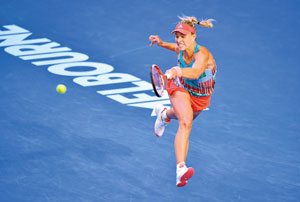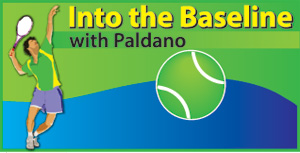Era of ‘Mega Weapons’ Angelique Kerber world’s number one
View(s):The end of the US Open last week, also signals the end of a major part of the international professional Tennis calendar for 2016. In the time leading to the recess, apart from the prize money which has risen to US$ 3.5 million to the winner of a Grand Slams, the only other interest for players is to be eligible for the Masters event, which means to be in the ‘Top 8’ of the world rankings.

The new World No.1, Angelique Kerber
Modern enhancements in equipment and athleticism have resulted in the development of ‘mega-weaponry’. One of the most feared shots in Men’s Tennis, is Argentinean Juan Martin del Potro’s forehand and in Women’s it is Czech Republic’s Karolina Pliskova’s service. To date, Pliskova’s service winners’ count stands at just over 400 aces for this year, while last year, it was 517.
On the Men’s side, Stan Wawrinka carried the Swiss flag in the absence of Swiss maestro Roger Federer at the US Open. He displayed a strong comfort zone in technique, game compilation and clinched the US Open title, his second Grand Slam title. His signature shot- the backhand down the line is a much feared weapon. It can whiz past opponents at over 100 mph, and the man Wawrinka eliminated to take the title was the invincible Novak Djokovic.
In Tennis, reaction and repetition in stroke-making, along with effective tactics, are essential attributes to engage and counter opponents. It has always been so. In good players, their precise patterns in shot selection leaves very little margin of freedom for opponents to venture into any form of exploitation. The ‘mega-weapons’ they carry are the lethal ‘icing on the cake’ which makes their game very dynamic, exciting and appealing.
It is in this backdrop of efficiency that the Top 20 players possess ‘mega weaponry’ with severe destructive effects. Even then, the use of ‘mega weapons’ is not an insurance anymore, as most players from the top 200 do their homework well, to defuse ‘mega weapons’. This was the saga at the US Open.
 New name – Pliskova
New name – Pliskova
The Czech Republic, formerly Czechoslovakia, was never short of good players. Martina Navratilova and Ivan Lendl were household names for decades. This year Karolina Pliskova, a Czech with clinical efficiency has made her presence felt in Women’s Tennis. The Tennis, her 6′ 2″ frame produces, can be described as ‘effortless’. She has an array of ‘mega-killer-weapons’ from the baseline and at the net. Apart from the shaky nerves in the 3rd set of the US Open final, where she lost to Germany’s Kerber, whom she beat in the Cincinnati final two weeks ago, her Tennis is built on a solid foundation. It is not at all surprising she sent the Williams sisters and a few other big names packing, on her way to the finals. In her interview, the 24-year-old Pliskova said, ‘I have mastered the art of performing on big stages’. She has a twin sister with equal potential in the circuit.
King and Queen
The big four in Men’s Tennis- Federer, Nadal, Djokovic and Murray- did not make it at the US Open. Djokovic was always known for his physical efficiency but, in the US Open, he was treated on court for his right and left wrist, shoulder and foot. The signs may be up for his reign as King of the court. Who will be the next No.1? It could be Japan’s Nishikori, Britain’s Andy Murray, Stanislas Wawrinka and in a long shot, Juan Martin Del Potro. These players have the skills and maturity, and Djokovic’s lead in points is fast shrinking.
Angelique Kerber is the new Queen of Tennis. She ended Serena Williams’ 183-week reign as No.1. Steffi Graf was the last German to be No.1 and held it for over 190 weeks. Kerber has deservingly taken the crown with the Australian and US Open titles this year, with no visible weakness in her Tennis right now. The dominating feature of her Tennis is her athleticism to cover court and her reaction speed. These permit her to perform in every space on the court, in extremely limited time. Like all of her calibre, there is no shortage of stroke ‘fire power’.
The Drop-Volley
The drop-shot uses ‘touch’ which is opposite of power, and its ample use in the US Open was a surprise. At net, players’ priority was to use the drop-volley, than the put away hard volleys. Most players cover the back of the court well. So the way to keep the ball far from the opponent at baseline is to use the drop-volley. On a good many occasions, when the rallies got longer, it was the drop-shot that decided the rally.
Anti-doping body WADA is changing sports and is becoming socially more respectable. It also places doubts on some performances in the recent past. However, we cannot jump to conclusions, as the players are innocent, unless proven guilty.
–George Paldano, Former intl. player; Accredited Coach of Germany; National, Davis-Cup, Federation Cup captain/coach– georgepaldano@yahoo.com


